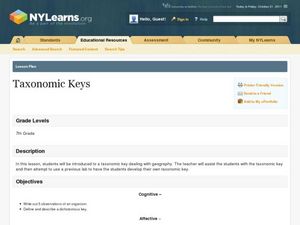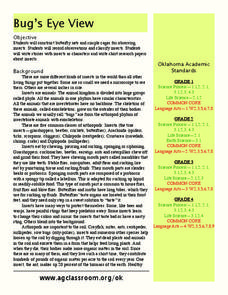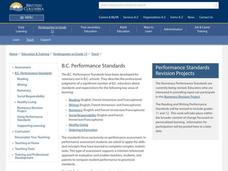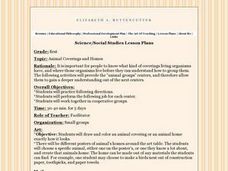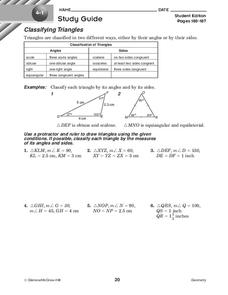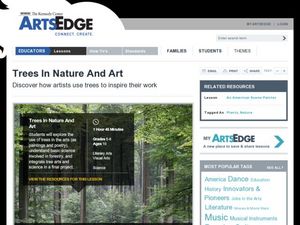Curated OER
Microbiology
In this biology worksheet, students identify and locate various vocabulary terms pertaining to microbiology. There are 54 biology terms located in the word search.
Curated OER
Taxonomic Keys
Seventh graders create their own dichotomous key. In this biology lesson, 7th graders classify animals based on their observable features. They explain how to use their dichotomous key.
Curated OER
The Battle of Stones River: The Soldiers' Story
Learners organize items in a "doohickey kit" distributed by the teachers, creating categories using classification schemes. In this classification lesson, young scholars compare systems within groups and write questions that could be...
Curated OER
Living and Non-Living
Fourth graders are divided into small groups and collect 4 objects from the playground. They take 5 to 10 minutes to classify their groups and discuss their findings including the terms "living" and "non-living". As a class they discuss...
Curated OER
Classifying Polygons
Pupils study polygons. In this math lesson, students play a game in which they learn the classification system for polygons. Pupils identify the properties of quadrilaterals.
Curated OER
Huey and Louie Meet Dewey
Students exercise their library shelving skills. Students complete a worksheet that aids a rambunctious student who needs their help. Students become familiar with the Dewey decimal classification system. Students organize books on the...
Curated OER
Diversity And Adaptations Of Organisms
Eighth graders study how and why animals are classified into eight groups in the animal kingdom. They work together to identify organisms. They use the key to determine the phylum for the included problems.
Curated OER
Creepy Critters
Students develop a classification scheme based on the structural features of organisms. In this organism lesson students divide into teams and complete a fun activity.
Curated OER
Keys and Classifying
Young scholars classify plants and animals. In this organisms lesson, students define classification and sort various objects according to its attributes. Young scholars then research wildlife of Utah and group the organisms into...
Curated OER
Classify That!
Students get acquainted with diverse forms of life by using modern biological classification systems to group animals that are related. They explore basic scientific groupings like genus, species, mammals, fish, birds, amphibians, and...
Curated OER
Dichotomous Keys
Students classify objects and organisms using a dichotomous key. They are shown a demo by the teacher and then practice on their own. They discover why classification is important.
Curated OER
Bug's Eye View
Learners explore biology by writing fictitious stories in class. In this insect life activity, students identify many different types of insects in the animal kingdom and the classifications they fall into. Learners collect insects on a...
Curated OER
Thiebaud Cake Math: Elementary
Students explore the American artist Wayne Thiebaud. They practice addition, subtraction, fractions, money problems, and classification problems by carefully examining his painting entitled Cakes. They create a bold cake painting.
Curated OER
Animal: Unique Creatures With Great Features
Students present models, oral reports, and presentations on animal's characteristics. They research various animals and the characteristics that link them to specific animal groups. They answer specific questions relating to animals in...
Curated OER
Hominoid Skull Comparison
Students are provided with evidence used to support evolutionary theory. They are introduced to classification by using primates as an example. Students read article related to Hominoid Skull Comparison and write a summary about the...
Curated OER
Childhood Obesity
Students identify a question to generate appropriate data and predict results. They distinguish between a total population and a sample and use a variety of methods to collect and record data. Students create classifications and ranges...
Curated OER
Animal Coverings and Homes
First graders research what kind of coverings living organisms have, and where those organisms live before they can understand how to group them. The following activities will precede the "animal groups" centers, and therefore allow them...
Curated OER
"Publication" of Scientific Papers And Posters
High schoolers create and display a scientific poster in the same format that scientists use at a research symposium. They compile data and make conclusions about the classification of the Arizona Hedgehog Cactus as an endangered...
Curated OER
The Rock Cycle
In this rock cycle worksheet, students study the diagram of the rock cycle and explain how minerals originally in magma could travel through the cycle. Then they identify how these minerals end up in each of three main classifications of...
Curated OER
Climate Types
In this weather worksheet, students identify the type of vegetation found in particular regions across the United States. Then they list the six groups of climates in the Köppen Classification System. Students also describe the...
Curated OER
Classifying Triangles
In this classifying triangles worksheet, 10th graders solve 6 different problems related to the classification of triangles either by their angles or by their sides. First, they use a protractor and a ruler to draw triangles using the...
Curated OER
Classifying Seashells
Third graders practice classifying seashells. In this seashell classification lesson, 3rd graders listen to a guest speaker talk about collecting seashells. They participate in a discussion on the characteristics by which seashells are...
Curated OER
The Three Worm Phyla
Ninth graders examine the three worm phyla. In this classification lesson plan, 9th graders observe, compare and contrast the planarian, tapeworm, and fluke.
Curated OER
Trees In Nature And Art
Learners study the use of trees in art. In this investigative lesson students create art using leaf rubbings and develop a classification method for trees.



